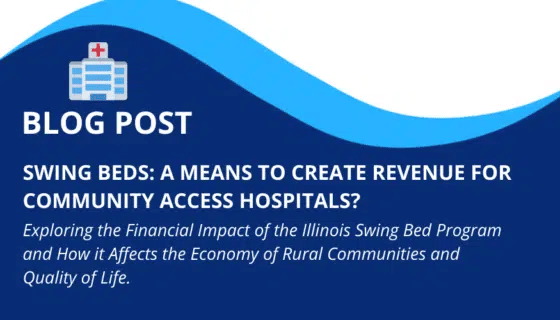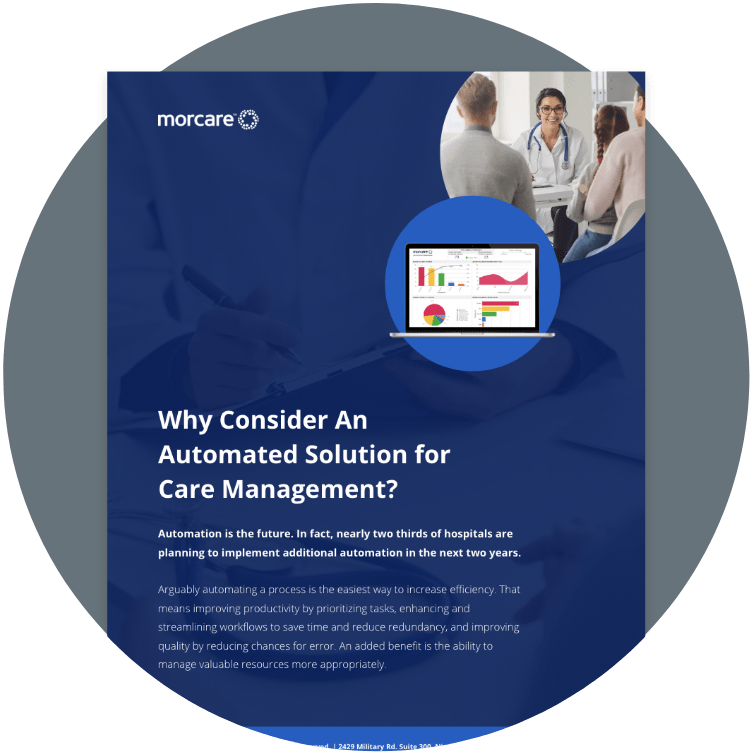SWING BEDS: A MEANS TO CREATE REVENUE FOR COMMUNITY ACCESS HOSPITALS?
Exploring the Financial Impact of the Illinois Swing Bed Program and How it Affects the Economy of Rural Communities and Quality of Life.
By: Tina DeWees
Last week’s National Rural Health Association’s Annual Conference featured a presentation, Illinois Critical Access Hospitals: Exploring the Financial Impacts of the Swing Bed Program by Mel Henriksen, CGS Assistant Director, and Dr. Hana Hinkle, Associate Director at the National Center for Rural Health Professions (NCRHP). This presentation highlighted findings from the Northern Illinois University and Illinois Critical Access Hospital (CAH) Network survey conducted in 2019. This survey and study found CAH swing bed patients have lower average lengths of stay and readmission rates compared to skilled nursing facilities while accessing quality healthcare professionals close to home. Ultimately, pointing to the conclusion that using vacant hospital beds for swing beds strengthens hospital and community financial stability.
The findings also helped critical access hospitals across the state highlight their policy concerns and suggestions for changes in legislation going forward. Although more research needs to be conducted nation-wide, this brings to the forefront a valuable opportunity for CAHs. Critical Access Hospitals (CAHs): Are rural hospitals given this specific designation as a result of having specific operational requirements that are different from their rural hospital counterparts. This designation is designed to reduce the financial vulnerability of rural hospitals and improve access to healthcare by keeping essential services.
Rural hospitals that meet CAH eligibility must meet these conditions:
- Fewer acute care in-patient beds (25 or less)
- Maintain an average length of stay of 96 hours or less for acute care patients
- Supply 24-hour emergency care services
- They are in designated rural areas that meet specific criteria (i.e. more than a 35-mile drive from another hospital, or more than 15-mile drive from another hospital in an area with mountainous terrain or only secondary roads
Swing Beds
Approved use of beds for acute care or post-hospital Skilled Nursing Facility (SNF) care.
Breaking Myths
One of the biggest misunderstandings about hospital swing bed facilities is that they are correlated to a higher cost of care. This is FALSE. In fact, research shows the quality of care is greater.
Facts, Figures and Impact
For facilities with Hospital Swing Bed Programs, it has been observed that these programs have a positive financial impact to CAH’s. The reimbursement structure for CAHs is different as they receive 101% of reasonable cost for their skilled nursing facility level services provided by Medicare. The perk, this = a revenue opportunity!
- When assessing quality of care from a SNF to a CAH, 40% of hospital admissions from a SNF may be avoidable due to the poor quality of care in Skilled Nursing Facilities.
- SNF’s have low nurse-to-patient-ratios, and often there is ambiguous data collected. For example, when it comes to-patients’ availability to on-site primary care providers. Whereas on the other hand, CAHs provide these types of services and patients are seen multiple times in a week by a PCP. This provides for a higher quality of care than SNF’s.
- Readmits rates are lower than a skilled nursing facility. Two thirds of swing bed patients were discharged to their homes, and approximately half of those receive home health services, and another 12% moved to external long-term care or nursing facilities.
- Swing bed revenues on average are 12.5% of all CAH inpatient revenues and some facilities receive a higher percentage of inpatient revenues from swing beds.
Moving Forward
As this study signified, there really needs to be a greater focus on hospital swing beds among CAHs as the margins are very small. Losing swing bed revenues would cause significant financial distress for already distressed CAH’S and the effect would be devastating to rural health efforts and rural communities.
How MorCare Can Help
Using a hospital swing bed program? Let us help. Our Provider Care Management solution allows organizations to effectively track a swing bed program and level of care, along with criteria and workflows in our system.
We document the ongoing progress of patients in our software in order to make sure delays are being tracked, and days are getting approved in this level of care. We also automate payor contacts and authorizations, and discharge planning processes to make sure patients are being aligned with the appropriate resources when it is time to go. We can help with this all while providing actionable information and insights through data analytics dashboards.
For more information on Swing Bed Providers: cms.gov
SOURCES:
Henrikson, M., and Dr. Hinkle, H. Illinois Critical Access Hospitals: Exploring the Financial Impacts of the Swing Bed Program. Oral presentation at: National Rural Health Association Annual Conference; June, 2020; Virtual Event.
Rural Health Information Hub. Critical Access Hospitals (CAHs) Introduction. Published 2019. Accessed June 25, 2020.

